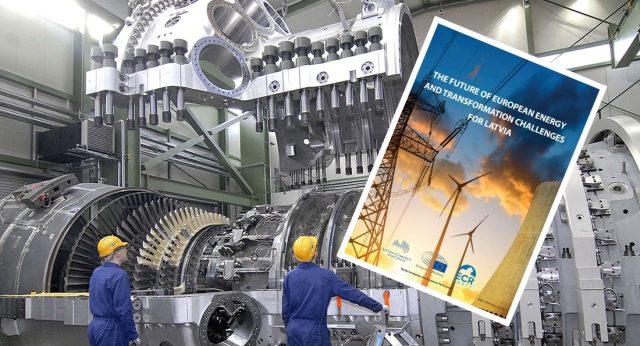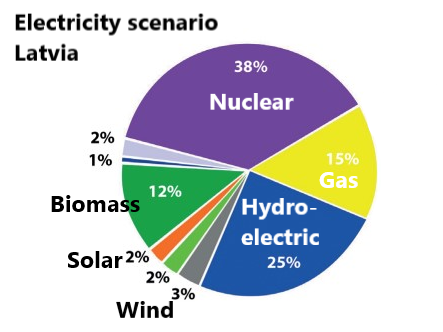
The challenges for Europe in energy policy are enormous. And not least for smaller countries like Latvia. A new study analyzes problems and opportunities.
Three years ago – before the pandemic and the Russian war of aggression against Ukraine – the European Commission presented a striving plan to make the EU climate-neutral by 2050.
To achieve this the Union and its member states needs to reassess the distribution of its energy portfolio and accelerate the progress toward fossil free energy solutions.
This was already a big task three years ago, but has become both more difficult and more important after the dramatic events of the past year.
EU needs to reassess its energy portfolio
Recent upheavals related to energy supply disruptions to Europe, as well as rising prices of key energy resources, have led to more urgent energy policy action. The high dependence on the import of energy resources and the sensitivity to geopolitical upheavals indicate that the EU needs to reassess the distribution of its energy portfolio and accelerate the progress toward sustainable energy solutions.
That is the message of the report “The Future of European Energy and Transformation Challenges for Latvia” is a study published by the Latvian Economists Association, with the support of The European Conservatives and Reformists (ECR) Party and with financial support from the European Parliament.
In the foreword Ojars Kehris, president of the Latvian Economists Association, states that EU for a long time haven’t prioritized energy and therefore a unified policy in this area has been lacking. The different capacity in this field in “old” member states compared with “new” are great. As a result, German consumers have had much lower energy prices than Latvians, for example.
A new situation
The last year’s event has created a new situation in energy in particular and the economy in general. To stop the dependence on Russian energy and diversify electricity generation methods and supply routes are important both for the Baltic States as well as the whole of Europe.
In the new study, research is presented that will be useful to decision-makers who need to build a new energy policy based on the contemporary demands placed on Europe.
In his foreword, Roberts Zile, the Vice President of the European Parliament, points out that Europe cannot implement green and fossil free energy in the same timeframe as planned before the Russian invasion of Ukraine. The new study shows how, in longer term, Europe in general and Latvia in particular can re-orientate from Russian gas and oil and achieve sustainability and Green Deal goals.
Still dependent on fossil fuels
The study makes clear that Europe is still dependent on fossil fuels. More than half of the EU’s total energy supply comes from oil, oil products and natural gas. And a large proportion came before the war from Russia.
Due to the events named above the price on natural gas has raised from 3 euros per megawatt hour (MWh) in the summer of 2020to a record high of 346 euros in August 2022. The cost for electricity has increased all over Europe. In Latvia from 31 euros/MWh in 2020 to the absolute peak of 4000 euros on August 17, 2022.
Creating a new energy portfolio
The study reproduces analyzes from several other reports that all come to some common conclusions. The transition to more fossil free energy can be achieved in the long term with various policy instruments, and by creating a relevant energy portfolio.
The transition aims to simultaneously achieve: (1) increasing efficiency in the use of electricity, (2) electrification of end-use, and (3) decarbonization of electricity generation.
An important component of all these scenarios that aim to significantly reduce the use of fossil energy sources is their replacement by nuclear power. “Overall, almost all scenarios reviewed an increase in nuclear power”, the study states.
Despite this finding, European countries it heavily investing in wind energy, both on land and offshore.
The study also highlights how solar photovoltaic modules, in the past ten years, have become much cheaper and more widely used. However, it is worrying that the prices of various components for solar panels have become in short supply with higher prices as a result. It applies to everything from polysilicon to copper.
Continued dependence on fossil energy
Despite all ambitions, Europe will continue to be dependent on fossil fuels, not least natural gas. To avoid Russian gas the import of gas from USA and Qatar will increase. It could be enough to cut of the Russian gas, if the planned increase in renewable energy sources (RES) and decline in the natural gas consumption take effect.
The report also points out the importance of recognizing the risks of volatile electricity prices on the market. It is also important to recognize the effect of the energy crisis on other areas. For example, several fertilizer production plants closed in the EU due to high energy prices that would have an impact on the next agricultural season and the food sector.
Scenario for Latvia
The Baltic States are still operating synchronously with the electricity systems of Russia and Belarus. Work is currently underway on the desynchronization project from the Russian-managed power network, with the goal of connect with the continental European grids in 2025. This development increases the need for local generation, as the Baltic States will have to be able to provide both balancing and stable grid operation.
For Latvia it is, on short terms, important to have more than one entry point to receive natural gas. The terminal in Klaipeda, with deliveries of gas from Lithuania in the south, will be complemented by a new terminal. It will be developed together with Estonia and Finland, north of Latvia.
 Based on the longer time horizon, Latvia is reviewing plans to build two small nuclear reactors with a total capacity of 600 MW. With them more than 4 TWh of electricity could be produced annually. They would then be able to supply up to half of the electricity consumed in Latvia, also taking into account that electricity consumption will increase over the next ten years.
Based on the longer time horizon, Latvia is reviewing plans to build two small nuclear reactors with a total capacity of 600 MW. With them more than 4 TWh of electricity could be produced annually. They would then be able to supply up to half of the electricity consumed in Latvia, also taking into account that electricity consumption will increase over the next ten years.
Build on the study’s assumptions and principles, electricity generation scenarios for Latvia have been able to be created. To the right is the scenario which includes the mentioned two nuclear reactors. A scenario without nuclear power means that wind power needs to become the largest source of energy and produce 31 percent of the electricity.
How to keep tariffs down
Finally, the study draw attention to the problem of insufficient power generation capacity in Latvia and the entire Baltic region. It is important to evaluate possible stimulating measures, to avoid separate and parallel public investments in infrastructure and by doing so reduce the tariffs.
When evaluating possible solutions in the energy sector, it is also necessary to follow the trends in the region, because the energy sector in Latvia cannot be viewed separately from the countries that are participants of the same energy market, the study states.
This balanced and thorough study will allow policymakers to see both the common European direction in energy and the special potential of Latvia in it, the Vice President of the European Parliament Roberts Zile sums up.



 Subscribe
Subscribe